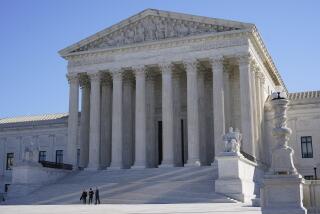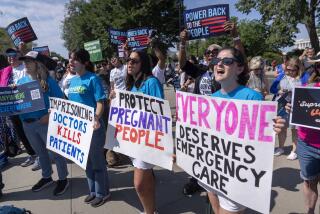Souter Appears Skeptical About Abortion Rule
WASHINGTON — The argument had gone on for nearly an hour Tuesday morning when the newest member of the Supreme Court, Justice David H. Souter, leaned toward his microphone and questioned a government anti-abortion position.
The issue before the justices was whether the Bush Administration may prevent doctors in federally funded clinics from telling poor, pregnant women about abortion.
Under questioning, Bush Administration attorney Kenneth W. Starr had conceded that, under the government rules, a clinic doctor has no choice but to refer a pregnant woman to a prenatal center, even if his examination discloses that her pregnancy could threaten her life.
Souter clearly seemed troubled by the government’s stand.
“You are telling us the physician cannot perform his normal professional responsibility,” Souter said. “You are telling us that (the government) may in effect preclude professional speech.”
Although the questions a justice asks during oral arguments do not necessarily indicate how he will vote on an issue, Souter--joined by Justices John Paul Stevens and Sandra Day O’Connor--repeatedly questioned whether the government policy unduly restricts doctors and jeopardizes the health of women.
If Souter should vote to strike down the government rules, he could tilt the decision in favor of the court’s shrinking liberal bloc. Even so, his vote in this case will not necessarily signal his views on broader abortion questions or the landmark Roe vs. Wade ruling that gave women the constitutional right to seek abortions.
The case at hand does not directly challenge Roe vs. Wade. But it does test whether the conservative court will let the government use its regulations to make abortions more difficult to obtain.
It is the first abortion dispute to reach the high court since its liberal leader, Justice William J. Brennan Jr., retired. Now, the outcome is likely to depend on Souter, his successor.
For years, Souter served on the board of a Concord, N.H., hospital and joined with other members in approving a hospital policy of offering abortions. But, during his confirmation hearings, Souter said that his support for the hospital policy did not mean he supports abortion, only that he viewed it as a currently legal option for women.
Four Supreme Court conservatives--Chief Justice William H. Rehnquist and Justices Byron R. White, Antonin Scalia and Anthony M. Kennedy--sounded during Tuesday’s arguments as if they support the Bush Administration policy.
Justices Thurgood Marshall, Harry A. Blackmun and Stevens have consistently supported a woman’s right to an abortion and probably will oppose the Administration position. If so, Souter and O’Connor will cast the deciding votes.
At stake is the advice given to 5 million poor women who each year visit 4,000 federally funded family planning clinics. Since 1970, Congress has funded these so-called Title X clinics to provide contraception, pregnancy testing and physical examinations to poor women and teen-agers.
Congress prohibited the clinics from offering or paying for abortions. In 1988, the Ronald Reagan Administration went one step further by issuing rules forbidding doctors or nurses to refer pregnant women to abortion clinics or even mention abortion as an option.
However, the rules say that a doctor “must” refer a pregnant patient for “appropriate prenatal” care for the benefit of her “unborn child.”
In the case before the court, doctors challenging this so-called “gag rule” say that it violates their constitutional rights to free speech and goes beyond the language of the law.
“We depend on our doctors to tell us the whole truth . . . whether we are in a Title X clinic or Bethesda Naval Hospital,” said Harvard University Prof. Laurence H. Tribe, who represented the doctors. “Truthful information is being deliberately withheld from these women. There is a censor overseeing the entire process.”
But the chief justice questioned whether the 1st Amendment limits the government’s control over its employees. The White House hires speech writers and public information officers who are permitted to say some things and not others, Rehnquist noted. Why, he asked, wouldn’t the same principle apply to federally funded doctors?
Doctors are “not speaking for the state,” Tribe said. “They are at the other end of spectrum.” He noted that a patient expects honest advice from a doctor, not a political message.
The free speech issue before the court parallels to some extent the controversy over the National Endowment for the Arts and its funding of allegedly obscene works. Some art advocates contend that the NEA may not impose limits on the ideas expressed in artwork. But critics say that the government may put any limits on how its money is spent.
Last year, the high court on a 5-4 vote said that a state may forbid abortions in its public hospitals. Moreover, the government may prevent its employees from “promoting” or “encouraging” abortion, the court said.
But Justice O’Connor, who provided the crucial fifth vote in that case, said that she would have balked had the state law prevented “health professionals from giving specific medical advice to pregnant women.”
That issue is now squarely before the court. A ruling in the case (Rust vs. Sullivan, 89-1391) can be expected early next year.
More to Read
Get the L.A. Times Politics newsletter
Deeply reported insights into legislation, politics and policy from Sacramento, Washington and beyond. In your inbox three times per week.
You may occasionally receive promotional content from the Los Angeles Times.











